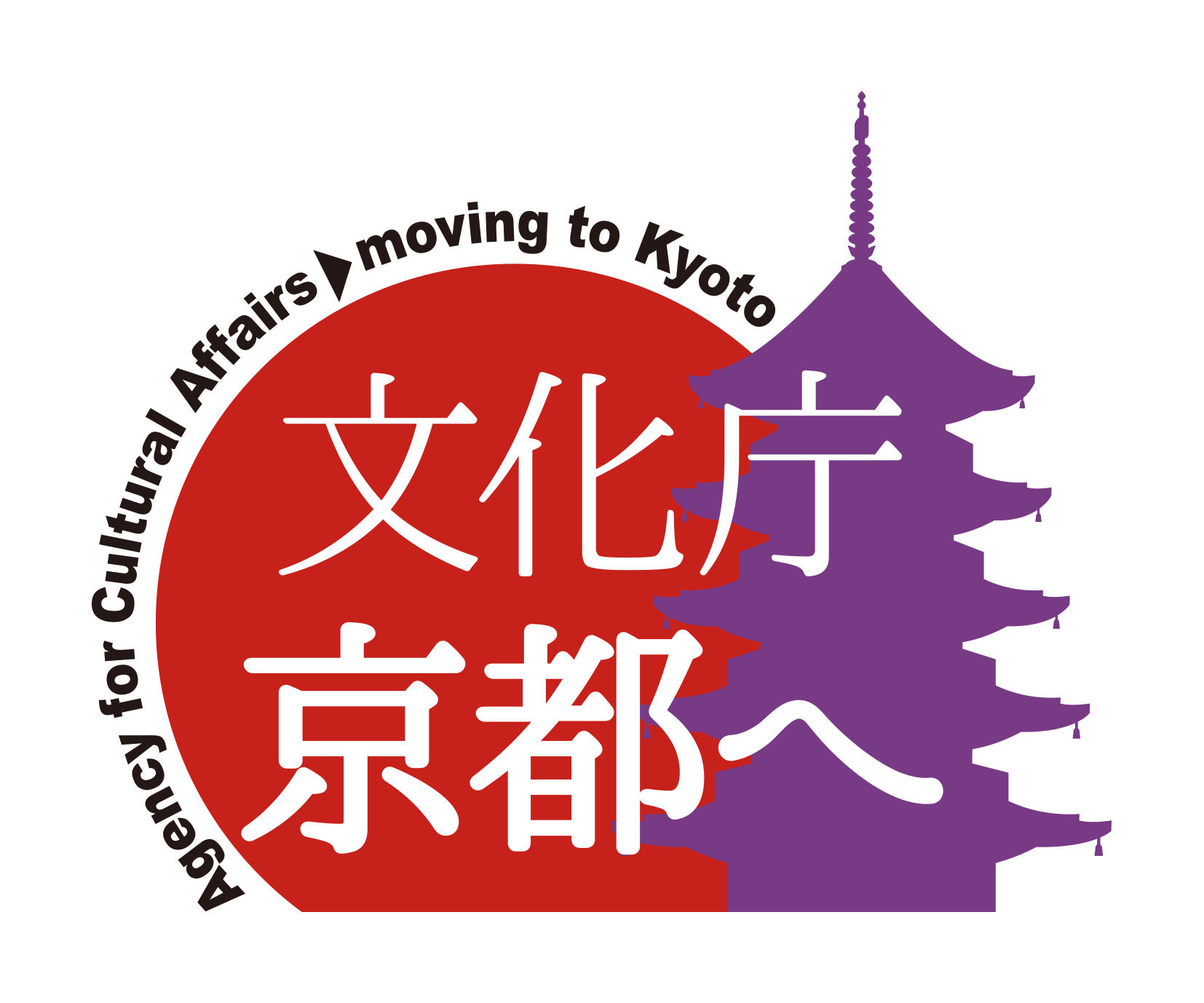Here, we will report on the class and the activities of the students of Kiyomizu-dera × Ritsumeikan University’s “Proposal for a barrier-free flow line around the highlights of the precincts of Kyoto’s famous temples and shrines” (in charge: Professor Shinsaku Munemoto).
Classes after the interim presentation
After the interim presentation on Saturday, October 24, a review meeting was held based on the impressions and comments from the interim presentation, and a meeting was held to present the results and create the final product, the video.
In preparation for the creation of the video, each class was given a total of about 15 minutes, 4~5 minutes, and cautions were given about the copyright of the background music to be used and consideration of portrait rights when shooting the video.
We also discussed points to keep in mind when using deliverable videos on tablets.
From now on, we will start shooting and producing full-fledged videos. I’m really looking forward to seeing what kind of videos you can make.
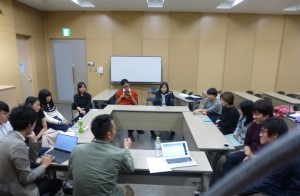
Preparation for the interim presentation
On Saturday, October 17, we had a rehearsal for the presentation for the interim presentation at Campus Plaza Kyoto. The class was attended by three teachers and Kiyoaki Mori of Kiyomizu-dera Temple, who gave advice on each group’s presentation. In addition, the order of presentations at the interim presentation was determined based on the content of each group, and as common advice, instructions were given that 4 to 5 slides were appropriate because the presentation time per group was 1 minute and 30 seconds, and that the manuscript should not be read during the mid-term presentation.
Nakajima Group “Kiyomizu-dera Pole -Gracefully Touring, Hoping, Knowing-“
Mr./Ms. Nakajima’s (Ryukoku University) group proposed the installation of original “spot seats” at attractions unique to wheelchairs and the route. The teachers said that it would be better to clarify the concept of “looking at the building from a little farther away” or “looking up from a wheelchair and appreciating the building” because it is an appeal to visitors in wheelchairs. There was also a suggestion that there might be an idea to have them look for it locally.
In addition, the order of presentation at the presentation was the fourth of the birds.
Washio Group “Shimizu Tourism with a Reduced Time Distance”
Mr./Ms. Washio (Ritsumeikan University) proposed a worship route that shortened both the distance and the time required to take into account the burden on worshippers in wheelchairs. The proposal included that it would be recommended to travel by car in places where cars are allowed. The report did not report a specific number of hours that could be saved, so we were instructed to check the actual time it would take.
In addition, the order of presentation at the presentation will be the second in the order of presentation.
Touhou Group “Take your time”
Mr./Ms.’s group (Ryukoku University) focused on the “degree of fatigue” caused by the difference in height within the precincts of Kiyomizu-dera Temple and proposed the establishment of three resting places. The teachers expressed the opinion that it is necessary to show in an easy-to-understand manner how much of a height difference there actually is in Kiyomizu-dera Temple, and that the perspective of the caregiver should be taken into account.
In addition, I was to serve as the top batter at the presentation.
Okazawa Group “Barrier-free from the line of sight”
Mr./Ms. Okazawa’s (Ryukoku University) group discovered that the location of the fire hydrant was easy for wheelchair users to see from a survey of the precincts so far, and proposed to create a map that would allow people to prepare themselves mentally for ‘what lies ahead’ at a glance under the theme of barrier-free sight. The teachers expressed their opinions that the image of “barrier-free line of sight” in the title of the presentation was difficult to understand, and that it should be improved.
In addition, the order of presentation is now third.
In response to these suggestions, the students will prepare for the mid-term presentation in one week.
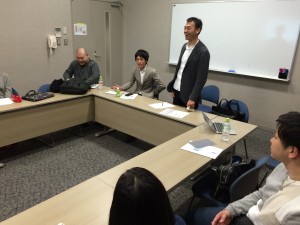
Video Story and Structure Draft Critique (Esquis) Part 2
In the class on Sunday, October 4, we continued from the previous class and critiqued the theme, point of view, and story of the video that will be the deliverable. The location was the same as last time, at the Entsuden of Kiyomizu-dera.
In the previous critique, the teachers pointed out the importance of discovering and proposing the pleasures unique to wheelchairs, rather than improving what cannot be done in a wheelchair, as a common issue for each team. This time, in response to these suggestions, each team gave a presentation on the concept of the video that they had reworked for about 30 minutes. In addition, we conducted an additional survey of the precincts using the free time of the critique.
In the group (1) led by Mr./Ms. Nakajima (Ryukoku University), suggestions were made on spots unique to wheelchairs and spots where people can stop, and several points where it is easy to see the surroundings, such as around the three-story pagoda, in front of the stage, and in front of the Koyasu Tower, were introduced. In addition, the concept of signage indicating such spots and the expression of images such as pulling back from the zoom was also reported. In response to this, the teachers expressed the opinion that keywords such as stopping and looking around, taking a leisurely tour from a point a little away with binoculars, or enjoying the view of Kyoto city from the precincts on a hill would also lead to the clarity of the proposal.
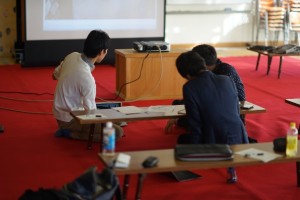
In group (2), led by Mr./Ms. Washio (Ritsumeikan University), the results of a survey were reported on proposals for more specific ways to enjoy the tour, such as drawing fortunes on stage, rather than whether you can go or not, as well as a tour of the Koyasu Pagoda by renting out car chairs and route proposals to avoid crowds.
In response to this, the teachers suggested that we should focus on the worship route and the time required for it, from the perspective of organizing the proposal and avoiding the crowds that we have been focusing on from the beginning. As a result of discussions with team members, it was decided to include a proposal for parking spaces for shuttle vehicles in the wheelchair tour route.
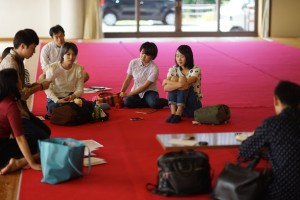
In Group (3), led by Mr./Ms. Higashikata (Ryukoku University), proposals were presented for enjoying together from the perspective of caregivers. Specifically, it was reported that there were points in the undulating precincts where wheelchairs could be stopped and a short break, and viewpoints that were “rewarded” in relation to the direction of movement of the wheelchairs. In response to this, the teachers suggested that as information for proposing these points, they should investigate the undulations of the route around the precincts and the conditions of the ground, such as cobblestones and gravel, which strongly affect the ease of pushing wheelchairs, and make proposals that incorporate these.
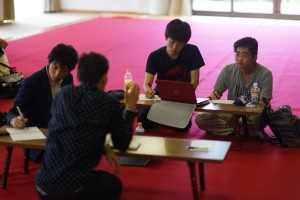
Group (4), led by Mr./Ms. Okazawa (Ryukoku University), presented a proposal to enjoy the scenery from the perspective of a wheelchair with a new concept of “barrier-free eyes.” We set up the stage, the Koan Pagoda, and the Otowa Waterfall as points to enjoy in wheelchairs, and proposed ways to devise ways to do so. The teachers suggested that more detailed points should be set to avoid handrails and crowds as highlights for wheelchair users. It was organized as a proposal to plot the highlights in more detail on the current barrier-free route, and to provide information on whether to leave the route on the left or right side of the route.
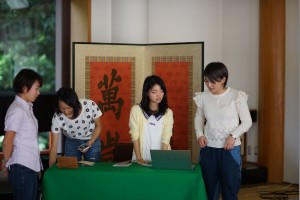
After each group’s presentation, the participants organized their work for the summary and interim reports. In the evening, a voiceover training was held at the Campus Plaza.
Draft review of the story and structure of the video (Esquis)
On Sunday, August 23rd, the class held a critique of the draft story of the video that will be the deliverable at the Entsuden Hall of Kiyomizu-dera Temple.
In this class, which was held at Kiyomizu-dera Temple on Saturday, July 18, each group conducted fieldwork in the temple grounds using a wheelchair. Then, as an extracurricular study, the students summarized the results of their fieldwork in groups and developed a draft of the video story that would be the final product. This class is a critique of the first draft.
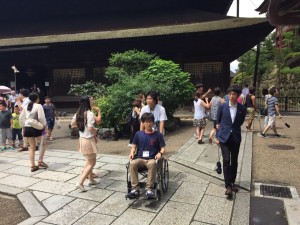
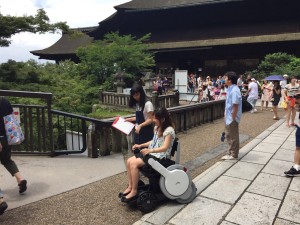
Fieldwork in the previous class
At the beginning of the class, the teacher gave a lecture on how to use video editing software and the differences between Windows and Mac for future video creation.
In the critique session that followed, each group had 40 minutes to present their proposals and receive critiques from the teachers.
In the group (1) led by Mr./Ms. Nakajima (Ryukoku University), it was reported that the buildings look different from usual when viewed from a wheelchair, and that when visiting the main hall, you can fully visit the Koyasu Pagoda and Otowa Falls without being on the stage with steps. In addition, depending on the slope of the approach, there are places where the path of wheelchairs becomes narrow, so we suggested that improvements should be considered.
In response to this, the teachers expressed the opinion that by more restricting the points unique to wheelchairs, it would be a more meaningful route for wheelchairs that have difficulty moving.
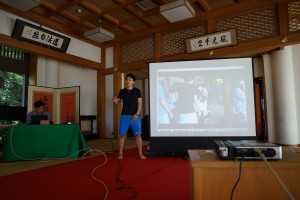
Group (2), led by Mr./Ms. Washio (Ritsumeikan University), initially envisioned a route that runs in the opposite direction of the general route, but when a field survey was conducted, it was actually difficult due to the large number of general worshippers, so a route was proposed to avoid congestion when visiting the regular route. In addition, since the route to the Koyasu Pagoda and the Jishu Shrine is difficult for wheelchairs to pass, we proposed the installation of a wheelchair lift leading to the Jishu Shrine in particular.
In response, the teachers suggested that they should add original discoveries to their proposals and find ways to avoid crowds while still being wheelchair-accessible.
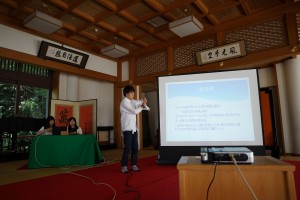
Group (3), led by Mr./Ms. Higashikata (Ryukoku University), proposed the installation of new ramps at Sui Kyudo Hall and Niomon Gate, as well as the creation of rest spaces for caregivers.
In response to this, the teachers suggested that from the viewpoint of feasibility, we should think about ways to enjoy wheelchair users in the current environment of Kiyomizu-dera, and that we should develop the idea of a caregiver’s perspective.
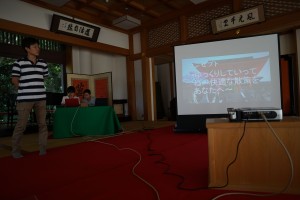
Group (4), led by Mr./Ms. Okazawa (Ryukoku University), proposed the concept of “sharing the excitement (of wheelchair users and caregivers)” and introducing a machine that eliminates the difference in eye height at the highlight spots, and investigating examples of other companies using videos and proposing that it would be effective to include guides and captions in the videos.
The professors suggested that it would be difficult to use large-scale machinery and equipment in terms of feasibility, so it would be possible to consider a method that could achieve the same effect in a simpler way by making use of this idea.
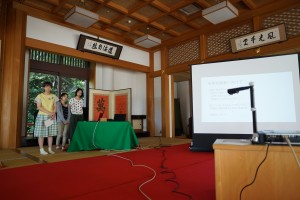
After each group’s presentation, the teacher summarized and explained the future work policy.
In addition, the students took advantage of their spare time for the presentations to conduct additional surveys and photographs of the precincts of Kiyomizu-dera Temple using wheelchairs, as they did in the previous session.
The next class will also be held at Kiyomizu-dera Temple, and each group will be able to flesh out the concept of the video.
Visit to Kiyomizu-dera Temple × the first day of the project
On Sunday, June 21, a class was held by Professor Munemoto of Ritsumeikan University, who is developing activities at Kiyomizu-dera Temple. This was the first time that Professor Munemoto’s class was held on Saturday, May 30, at a joint opening ceremony and general orientation with other subjects, so this was the first time that he had a class held alone. On this day, which was the first day of the project, classes were held at Kiyomizu-dera Temple.
The theme of Professor Munemoto’s class is “discovering new highlights of Kiyomizu-dera Temple and proposing further ‘universal design.'”
With a history of more than 1,200 years, Kiyomizu-dera Temple is one of the most popular tourist destinations in Kyoto, with more than 50 million tourists visiting annually (as of 2013). Kiyomizu-dera Temple is built at the foot of Mt. Otowa, and there are steep slopes and stone steps in the temple grounds. At Kiyomizu-dera Temple, we have been working to make the precincts barrier-free by paving the approach road and installing ramps for more than ten years so that wheelchair users and the elderly can visit the temple, and now wheelchairs can go around the precincts.
The purpose of Professor Munemoto’s class is to explore the attractions in the precincts of Kiyomizu-dera Temple from a barrier-free perspective, propose the charms they have discovered and new flow lines around them, and produce a video to introduce them as the final product.
At the beginning of the class, Mr. Kiyoaki Mori of Kiyomizu-dera Temple gave a lecture on the history and transformation of Kiyomizu-dera. In the lecture, he explained that Kiyomizu-dera Temple has a history of 1,200 years of taking on numerous challenges while respecting tradition and cultural properties, and that barrier-free access was one of those changes, and that the fact that it has been able to overcome crises such as repeated fires and wars is the result of being watched over by the local people for 1,200 years without fail. He said that he would like to make Kiyomizu-dera a temple loved by many people in the future.
After Mr. Mori’s lecture, the participants were divided into groups in a unique way, which Prof. Munemoto himself experienced when he studied abroad as a student. From now on, the activities of this group will be based on the activities.
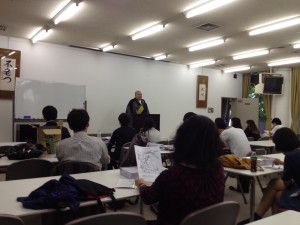
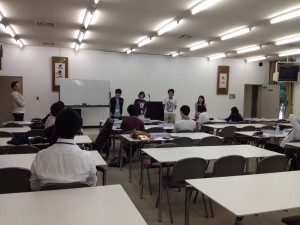
After that, under the guidance of Mr. Mori, each group toured the precincts of Kiyomizu-dera Temple. The halls and gates of Kiyomizu-dera Temple were destroyed and rebuilt due to fires at different times, and even the existing ones were built at different times. He carefully explained each of Kiyomizu-dera’s cultural properties, such as the fact that the design and style differ depending on the era in which it was built, the introduction of the Kannon statue with its unique appearance, and the story of the secret Buddha. In addition, he explained the concept and points of making the precincts barrier-free while actually showing us around the site.
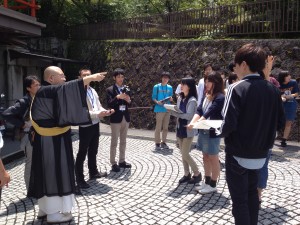
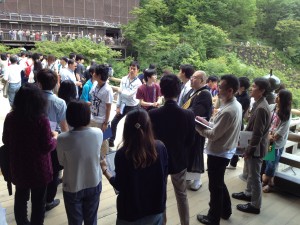
After the tour of the precincts, each group immediately held a strategy meeting, and some groups went to the precincts again to investigate. At Kiyomizu-dera Temple, which is one of Japan’s leading cultural heritage sites and tourist destinations, I have high hopes for the students’ future efforts to discover unknown attractions.
















